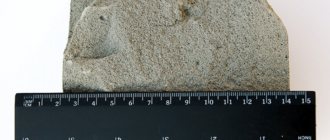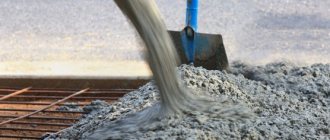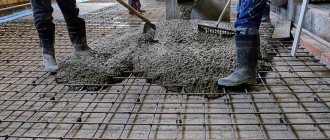Set retarders and anti-frost additives for concrete
Some retardation of setting may be useful for monolithic concrete: during long-term transportation of the mixture or when there are interruptions in its installation. In some cases, it allows one to avoid working concreting joints. Retarders can also be used when concreting in hot weather. Known retarders are sugars (glucose, fructose, etc.), feed sugar molasses, and crude ligno-sulfonates (containing sugars). Other additives are also used (citric acid, sodium gluconate, etc.). Some plasticizing additives also slow down the setting of concrete (for example, lignosulfonates). The dosages of set retarders are small: 0.1-0.15% by weight of cement, and the effect, regulated by the consumption of the additive, can be very significant: retardation of set from several hours to several days, and in case of overdose - generally for an indefinite time. Even a limited slowdown in the hydration of cement in a concrete mixture usually extends to the hardening of concrete, causing a smaller increase in strength at an early age. The effect of additives - retarders, like many other additives, depends on the characteristics of the cement, the temperature of the mixture and a number of other factors, so their dosage should be determine in experiment. This takes into account not only the retardation of setting, but also the effect of additives on the hardening kinetics of concrete. According to GOST, these additives should ensure a retardation of concrete setting by 30% or more, with a decrease in strength at the age of 28 days by no more than 5%.
Retarder additives can also be used in case of sudden delays in the delivery or placement of concrete mixture. The driver of the concrete mixer truck should have with him a solution of the retarder additive and data on the relationship between the dosage and the retarding effect.
Antifreeze additives
The use of anti-frost additives is one of the winter concreting techniques. It can be carried out separately or in combination with other techniques (thermos method or various methods of additional heat supply to molded concrete). In the latter case, the role of antifreeze additives is limited to protecting the concrete mixture from freezing during its delivery and placement. The physical basis for the use of antifreeze additives is to reduce the freezing point of water when salt is dissolved in it. In a simplified way, we can imagine that salt ions “interfere” with the formation of the crystal lattice of ice when the water temperature decreases. Therefore, the higher the concentration of the solution, the lower its freezing temperature. The decrease in freezing temperature reaches -21 ° C (at a solution concentration of 23%). Having determined the maximum negative temperature at which the concrete mixture should not freeze, the required solution concentration for this is found from the diagram. In this case, it is better to calculate the additive as a percentage of the mixing water. This gives more reliable results, since it is the concentration of salt in the water that determines the freezing point. In practice, cement additives (especially complex ones) are more often referred to as additives. It should be taken into account that the higher the W/C of the mixture, the lower the salt concentration in the water and the higher the freezing point of the mixture. Basically the same salts that are used to accelerate the hardening of concrete are used as antifreeze additives. Considering the restrictions on the use of chloride salts, the main trend in this area is the use of chloride-free additives. Antifreeze additives are used, as a rule, in the form of complexes. In particular, their combination with plasticizers will reduce the W/C and further accelerate the hardening of concrete, which is especially important during winter concreting.
GOST provides two options for using antifreeze additives:
- for “cold” concrete and mortar: ensuring hardening at low temperatures. In this case, the additives should provide, before freezing the concrete, depending on its class, a set of 30-50% of the 28-day strength of control concrete of normal hardening;
- for “warm” concrete and mortar: ensuring the mixtures are protected from freezing for the period from production to installation and supply of external heat. In this case, a set of at least 95% of the 28-day strength of the control concrete of normal hardening must be ensured.
It should be noted that antifreeze additives not only protect the mixture from freezing, but also ensure its hardening at subzero temperatures. But the hardening speed is quite low.
www.uniexo.ru
Retarders
Slowing down the setting of cement paste can be achieved by introducing special substances into the mixture - retarders. They also tend to retard dough hardening, although some salts can speed up setting and at the same time reduce the rate of strength development.
The use of retarders is advisable when concreting in hot conditions, when, as a result of exposure to elevated temperatures, normal setting times are reduced. Delayed curing caused by retarders can be used to produce an architectural finish on concrete elements. To do this, a retarder is applied to the inner surface of the mold walls, which helps slow down the hardening of the cement layer adjacent to the walls. After the forms are stripped, the boundary layer of concrete is cleaned out, leaving the concrete surface with an aggregate texture.
The retarding effect is exerted by sugar, carbohydrate derivatives, soluble zinc salts, soluble boric acid salts, etc. In practice, the most commonly used moderators are those that are also plasticizing additives. When using retarders, it is necessary to pay special attention to their correct dosage, since otherwise they can interfere with the setting and hardening of concrete. There have been cases of seemingly inexplicable reduction in concrete strength when sugar bags were used to transport aggregate samples to the laboratory or when black molasses bags were used to transport freshly prepared concrete mix.
It has been revealed that when sugar is added to cement in an amount of only 0.05% of the weight of cement, the strength of concrete at one day of age is reduced to zero and at 3 days of age - to 50% of the strength of the same concrete without the addition of sugar. However, the results of various studies are very contradictory. For example, a similar amount of sugar has been reported to increase 3-day strength by 10% and later-life strength by 20%. However, due to delayed setting, the intensity of strength growth in the first three days was reduced. A possible explanation for these inconsistencies could be that delayed setting promotes the formation of a denser gel and hence higher final strength. Because of these conflicting data, sugar is not generally used as a moderator. There is no doubt that it is highly desirable to first determine in practical application the effect of a specific retarder on test batches prepared with the cement that will be used in construction.
The practical use of sugar is possible to prevent cement from setting, for example in cases where a broken concrete mixer or slurry basin cannot be quickly emptied. However, too much sugar can have the opposite effect. Despite its low strength, quick-setting cement is difficult to remove from containers.
Retarding additives for concrete
Table of contents:
Retarders
Mechanism of action of retardants
Additional purpose of concrete additives
Types of retarding additives for concrete
Any concrete is exposed to impacts during all life cycles, from transportation to the site to the operational period. The composition of the concrete mixture includes standard components, which are also affected by external and internal factors, therefore, to protect both the composition as a whole and its components, certain additives are introduced into the mixture in amounts of up to 10% of the total mass. These additives provide a variety of functions and have different meanings, acting in certain conditions. Let's look at some of them:
Retarders
In what cases are inhibitor additives used?
The purpose of concrete additives is primarily to protect against destructive influences and maintain optimal properties, accelerate reactions and enhance the action of components, but not always. There are cases when additives are designed to slow down the process; retarders perform this function, increasing the hardening time of the solution. Let us describe the most popular cases of their use:
- in the production of high-quality mixtures.
In such concretes the content of the binder component is very high. This allows both to increase the strength of future concrete and at the same time accelerates the hardening process, thereby reducing the time required for delivery, pouring and proper installation of high-quality mixtures.
— transportation of the mixture over long distances and in heavy traffic conditions. Sometimes concrete mixer trucks and mixers do not cope with their task if long-term transportation is required in difficult road conditions. The use of retarders gives additional time to carry out mandatory procedures without losing the quality of the mixture.
— step-by-step concrete pouring.
Large building structures sometimes require phased pouring, since the amount of concrete, shape or pouring technology does not allow this to be done once. In this case, the mixture must remain in its state for a long time. To prevent the formation of cold joints due to loss of mortar fluidity, retarding additives are used.
There are other uses for retardation additives, but they are less common.
Mechanism of action of retardants
The mechanism of action of these additives is very simple. The reason for concrete hardening is the interaction of cement and water and the task of the retarder is to block this effect for a certain period until irreversible hardening occurs. In other words, additives slow down the process of hydration of the composition, the hydrolysis of clinker minerals is inhibited, which delays setting and does not allow the composition to harden ahead of time. Usually the setting process can be delayed for several hours.
Additional purpose of concrete additives
The purpose of additives is not only to protect the mixture, but also to preserve its properties and characteristics. Therefore, retarding additives include water reducers, which reduce the concentration of water, thereby slowing down hydration.
Retarding admixtures not only reduce the speed of setting of concrete, they also affect its workability, increasing the duration of this process. As well as the effect of temperature, retardant additives also affect the workability and set displacement. When choosing the latter, it is necessary to take into account the temperature factor and that it may affect the planned processes.
Concrete retarders can also affect the rate of hardening of the mixture at the initial stage of its hardening, reducing it. This is necessary during chemical interactions with the composition, when a large amount of heat is released as a result. This is acceptable for small pours, but on large objects a sudden loss of heat can affect the properties of concrete.
Types of retarding additives for concrete
Specific substances that help slow down the setting and hardening process include the following types:
- Linamix P 120 (90)
- Linamix SP-180
- Linamix PC
- Linamix RS
- Polyplast Retard
- Linamix PC type 2
These moderators perform not only a direct function. Sometimes concrete retarding admixtures are used in combination with other admixtures to achieve multiple objectives.
rus-stroy.net
CHAPTER 2. Special cements
Hardening accelerators and retardersSome properties of cement can be changed by using appropriate additives, which will reduce the use of special cements. Industry produces a large number of such substances. Their effect on the properties of cement is indicated by manufacturers, but the specific effect of each additive must be carefully checked before its direct use. This book will cover only two basic and well-tested types of additives: one accelerator group and one retardant group. The accelerating or retarding effect relates to the increase in strength, but not to the setting of the cement.
Calcium chloride
The introduction of calcium chloride into the concrete mixture increases the intensity of strength growth, and this accelerator is used when concreting is necessary at low temperatures (in areas with temperatures from -11 to -7 ° C) or for urgent repairs.
Calcium chloride increases the rate of heat release of the mixture during the first few hours: it appears to catalyze the hydration reaction of C3S and C2S. Hydration of C3A with the introduction of calcium chloride is slowed down to some extent, but the normal process of cement hydration is not disrupted. Calcium chloride can be added to quick-hardening and ordinary Portland cement. The higher the hardening speed of the cement itself, the earlier the effect of the accelerator appears. However, calcium chloride cannot be used with aluminous cement. Rapid-hardening Portland cement, as a result of the addition of CaCl, can reach a strength of 70 kgf/cm2 at the age of 1 day, while ordinary Portland cement can achieve this strength only on the 3-7th day. By 28 days of age, the strength of quick-hardening cement with and without the addition of CaCl2 is almost the same, but ordinary Portland cement with the addition of CaCl2 has greater strength than without the additive.
The results of studies carried out by Hickey on various types of cements are shown in Fig. 2.12. It is believed that the addition of CaC12 does not affect the long-term strength of concrete. Calcium chloride generally contributes more strongly to the early strength of high-fat, low-water-cement ratio mixtures than to lean mixtures.
The amount of CaCL added to the mixture should be carefully controlled. When calculating the required amount, it can be assumed that the addition of 1% of the weight of cement (CaCL) has the same effect on the hardening rate as an increase in temperature by 6°. The addition of calcium chloride in an amount of 1-2% is usually sufficient. Calcium chloride accelerates setting, and excessive amounts of CaCL can cause instant setting. Below are data showing the effect of CaCL on setting times. The addition of CaC12, accelerating the setting, is useful during repair work, for example when a water leak must be quickly stopped.
It is important that the calcium chloride is evenly distributed in the mixture, this is best achieved by dissolving the additive in the mixing water before introducing it into the concrete mixer. It is advisable to pre-prepare a concentrated solution
In cases where there is a danger of reducing the durability of concrete as a result of external influences, the addition of calcium chloride is not recommended. For example, the resistance of cement to sulfate aggression is reduced as a result of the addition of CaCL, especially in lean mixtures. If the aggregate is reactive, there is an increased risk of an alkali reaction with the aggregate. However, when this reaction is effectively controlled by the use of low-alkali cement and the introduction of active mineral additives, the effect of CaCL is very small. Another negative effect of the CaCL additive is that it increases shrinkage by about 10% and possibly also increases creep. Although the addition of CaCL reduces the dangerous effects of frost during the first few days after concrete is placed, the frost resistance of concrete with air-entraining additives deteriorates later in life, as evidenced by the data shown in Fig. 2.13. On the other hand, it was found that CaCL increases the resistance of concrete to erosion and abrasion, and this resistance is maintained at any age.
The possibility of corrosion of reinforcing steel as a result of the addition of calcium chloride to concrete has not yet been sufficiently studied, but the US Bureau of Claims, a large consumer of concrete, believes that there is no evidence yet that the use of calcium chloride in the appropriate amount has a negative effect on the corrosion of reinforcement K In more porous concrete, obtained using a high water-cement ratio, some corrosion of the reinforcement is observed at an early age, but it does not progress. It has been revealed that the use of calcium chloride leads to corrosion of prestressed wire, so it should not be used in the production of prestressed reinforced concrete. The same applies to steaming, since there is a serious danger of severe corrosion of the fittings. However, when unreinforced concrete is steamed, CaC12 increases the strength of the concrete and allows the use of an increased rate of temperature rise to reduce curing time.
The effect of sodium chloride is less intense than that of calcium chloride. In addition, the effect of NaCl is less stable; a decrease in the heat of hydration and a drop in strength by 7 days and later are also noted. Therefore, the use of NaCl is undesirable.
Retarders
Slowing down the setting of cement paste can be achieved by introducing special substances into the mixture - retarders. They also tend to retard dough hardening, although some salts can speed up setting and at the same time reduce the rate of strength development.
The use of retarders is advisable when concreting in hot conditions, when, as a result of exposure to elevated temperatures, normal setting times are reduced. Delayed curing caused by retarders can be used to produce an architectural finish on concrete elements. To do this, a retarder is applied to the inner surface of the mold walls, which helps slow down the hardening of the cement layer adjacent to the walls. After the forms are stripped, the boundary layer of concrete is cleaned out, leaving the concrete surface with an aggregate texture.
The retarding effect is exerted by sugar, carbohydrate derivatives, soluble zinc salts, soluble boric acid salts, etc. In practice, the most commonly used moderators are those that are also plasticizing additives. When using retarders, it is necessary to pay special attention to their correct dosage, since otherwise they can interfere with the setting and hardening of concrete. There have been cases of seemingly inexplicable reduction in concrete strength when sugar bags were used to transport aggregate samples to the laboratory or when black molasses bags were used to transport freshly prepared concrete mix.
It has been revealed that when sugar is added to cement in an amount of only 0.05% of the weight of cement, the strength of concrete at one day of age is reduced to zero and at 3 days of age - to 50% of the strength of the same concrete without the addition of sugar. However, the results of various studies are very contradictory. For example, a similar amount of sugar has been reported to increase 3-day strength by 10% and later-life strength by 20%. However, due to delayed setting, the intensity of strength growth in the first three days was reduced. A possible explanation for these inconsistencies could be that delayed setting promotes the formation of a denser gel and hence higher final strength. Because of these conflicting data, sugar is not generally used as a moderator. There is no doubt that it is highly desirable to first determine in practical application the effect of a specific retarder on test batches prepared with the cement that will be used in construction.
The practical use of sugar is possible to prevent cement from setting, for example in cases where a broken concrete mixer or slurry basin cannot be quickly emptied. However, too much sugar can have the opposite effect. Despite its low strength, quick-setting cement is difficult to remove from containers.











